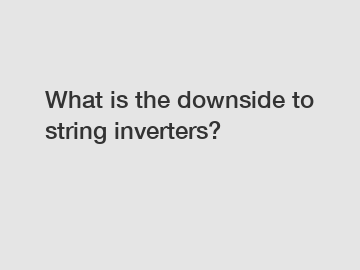What is the downside to string inverters?
What is the downside to string inverters?
String inverters are widely used in solar power systems to convert the direct current (DC) generated by solar panels into alternating current (AC) for use in homes and businesses. While string inverters have many advantages, there are also some downsides to consider. In this article, we will explore the drawbacks of string inverters and why alternative options may be worth considering.
1. Efficiency limitations:

One of the primary downsides of string inverters is their efficiency limitations. In a solar power system, strings of photovoltaic (PV) panels are connected to a single inverter. However, the efficiency of a string inverter is determined by the lowest-performing panel. This means that if one panel is affected by shading, dirt, or any other issue, the entire string’s output can significantly reduce. Consequently, the overall system efficiency suffers, impacting the energy production potential.
2. Limited flexibility and scalability:
Another significant disadvantage of string inverters is their lack of flexibility and scalability. String inverters require all panels in a string to be wired together in series. This wiring configuration may limit the system's adaptability to different site conditions and panel orientations. Furthermore, the size and capacity of the inverter must be carefully matched with the total wattage of the connected panels. As a result, adding or removing panels to the system can be challenging and may require additional inverters, ultimately increasing costs and complexity.
3. Safety concerns:
String inverters pose potential safety concerns due to the high voltage present within the strings. In case of a fault or malfunction in one panel, the entire string is affected by the decreased performance or, in some cases, complete shutdown. Consequently, troubleshooting such issues becomes more complex and potentially risky. Moreover, when the system needs maintenance or repairs, rooftop workers may be exposed to higher voltages if proper safety measures are not followed.
4. Partial shading limitations:
String inverters are particularly susceptible to performance degradation from partial shading, dust, or debris accumulation on individual panels. Even if just one panel within a string is affected, it can significantly reduce the output of the entire string. For installations where shading is prevalent, such as urban environments with tall buildings or nearby trees, micro-inverters or power optimizers may be a better choice. These technologies ensure that each panel operates independently, optimizing energy production despite shading on specific panels.
5. Monitoring challenges:
Monitoring the performance and operation of a solar power system using string inverters can be more challenging compared to other inverter technologies. Since string inverters aggregate the output of multiple panels, it becomes difficult to identify issues with specific panels or pinpoint the cause of underperformance. This lack of granularity can hinder effective troubleshooting and maintenance, potentially leading to prolonged system downtime and decreased energy production.
In conclusion, while string inverters have been extensively used in solar power systems, they do come with certain downsides. Efficiency limitations, limited flexibility and scalability, safety concerns, partial shading limitations, and monitoring challenges are some of the key drawbacks associated with string inverters. As solar technology continues to evolve, alternative options such as micro-inverters and power optimizers are gaining popularity. These alternatives address many of the downsides of string inverters and provide enhanced system performance, improved safety, and increased energy production potential. Therefore, it is crucial to carefully evaluate the specific requirements and site conditions before deciding on the inverter technology that best suits your solar power system.
Contact us to discuss your requirements of robust three phase string inverter, buy single phase string inverter, buy high voltage lithuim battery. Our experienced sales team can help you identify the options that best suit your needs.


